High temperatures can generate production problems in industrial plants or uncomfortable environment in public or private edifications. In order to avoid these situations more efficiently, cooling plants are the solution. ARANER can supply high quality cooling plants with proven solutions in:
- District Cooling plant, where the production and distribution of cooling energy is centralized.
- Turbine Inlet Air Cooling (TIAC), whose objective is cooling down the intake air of the gas turbine and provide power output augmentation.
- Turbine Inlet Air Cooling with Thermal Energy Storage, same objective than TIAC but adding tank storage to cater for cooling peak demands.
- Any other application which requires high demand of cooling capacity.
These plants consist of mechanical and electrical equipment that together enable cooling production. The different electrical equipment used in cooling plants will be analysed in this abstract.
Transformers: oil or dry?
There are two types of power transformers: oil and dry type. Each one has its advantages and disadvantages.
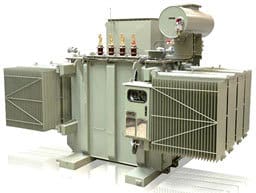
Figure 1: Oil Transformer (source ABB)
Oil transformer benefits
- Silent operation
- Outdoor application is possible
- Good performance in contaminated environment
- Potential fire and safety hazard
- Complex civil construction
- More frequent maintenance
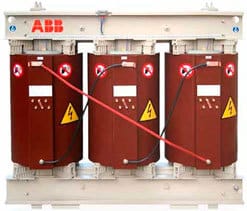
Figure 2: Dry Transformer (Source ABB)
Dry transformers advantages
- Can be located closer to the load, which involves cost saving in cable and less voltage drops.
- In the event of fire they are low smoke and avoid fire propagation, thus they are advised for indoor installation.
- They shall be modified in case they are installed outdoor (add louvers, heaters, coil insulation system…)
- Noisier
- Limited by size and voltage rating.
District cooling plants usually are located in the middle of the city and due to space constraints plants are congested. Also, in some cases, these plants can be underground. Dry transformers are more indicated for these applications. In the case of TIAC and TESTIAC, it depends on the space available. If there are no space limitations oil transformer can be used, but if the electrical equipment shall be installed in a container, dry transformer is preferred.
Medium voltage panel
In order to distribute the energy to the medium voltage loads, primary or secondary distribution panel options can be used. 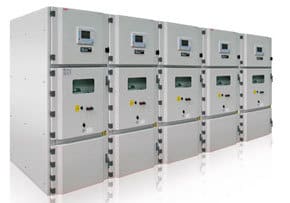
Figure 3: Primary MV Switchgear (Source ABB)
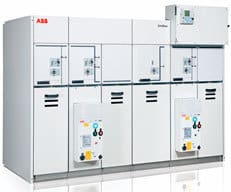
Figure 4: Secondary MV Switchgear (Source ABB)
Secondary distribution panels are frequently used in District cooling plant, where maximum short-circuit level is up to 25kA, current up to 1250A and voltage up to 36kV. If the space is limited, this kind of panel is more compact. But, if higher ratings are necessary, primary distribution panel shall be used. Panels can be gas-insulated (GIS) or air-insulated (AIS). The most widely used in cooling plants are air-insulated panel. They have advantages such as they can provide a higher number of operations, more economical or they have low maintenance requirements. Furthermore, AIS do not have problems about SF6 supply and due to this fact, in GIS type, internal faults often lead to long outage periods. As a rule of thumb, if there are space limitations, GIS type will be used.
In case of emergency
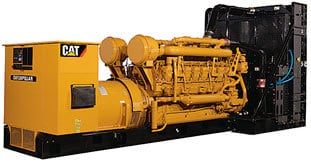
Figure 3: Generator (Source Caterpillar)
Depending on the nature of the plant, an unexpected shutdown may be very costly and not acceptable. The service of these plants cannot be interrupted; they need to provide continuous cooling distribution to their clients. In order to prevent this kind of problems, an emergency power supply source, as a generator, should be installed. In case of shutdown, the generator can provide the necessary power to feed the plant or at least the critical loads, while the problem is solved. In all types of cooling plants, it is recommended to have an uninterruptible power supply (UPS) that provides an instantaneous energy supply in case of input power interruptions. The energy is stored in batteries and provides a backup of a specific period, avoiding the shutdown of critical equipment control systems. The UPS allows a controlled start/shutdown of the main equipment and enables a proper diagnose of possible problems prior to plant restart.
Cables
Depending on the application, there are different kind of cables that can be used to improve the quality of cooling plants. Certain additives can be used to modify the performance under certain external conditions (i.e oil resistant cables) or cable constructive form can be modified to perform better with certain perturbations (i.e magnetic fields). Some equipment generate a huge amount of harmonics, which in long-term or big amounts can be harmful to the supplied equipment (i.e motors or transformers), reducing its life cycle. To avoid this problem, shielded cables shall be used. This feature confines the electromagnetic noise to the internal part of the cable and reduces the electromagnetic emissions of the line. In terms of safety, if cables are installed in places poorly ventilated, low smoke zero halogen cables (LSZH) are recommended. When cables have halogen content, if they burn they produce harmful gases that are toxic for people and also hazardous for close equipment. LSZH cables, not only avoid these problems, but they are also low smoke emission, what enables people to escape, see and breathe easier in case of fire. When the cable is installed underground, it should have higher protection degree in order to withstand mechanical efforts, rodents or errors during future excavations. In this case armoured cable shall be used. Another way to provide the cable with additional mechanical endurance, is to have an outer sheath of graphite. This is usually used in difficult underground or duct pulling installations to provide a mechanical protection.
Cables or bus duct?
Traditionally cables are installed to connect between transformers and panel or between panels. In some cases, the incomer panel rating is very high. In this case the cable size is big and there is a huge amount of cables per phase. In addition to this cost, the difficulty of installation and termination shall be taken into account, as cables of these dimensions are very heavy and difficult to handle.
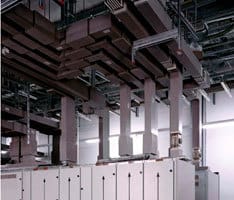
Bus duct is an aluminium case containing either copper or aluminium busbars that conduct electricity. It is pre-manufactured in sections and shall be assembled at site. Installing busduct instead of cables involves a decrease in the cost, but has certain limitations. Busduct installation shall be very accurate, the floor shall be perfectly levelled and there must be a provision of supports or ceiling fixations, so busduct is easier installed where the distance needed is shorter.
Get the correct electrical equipment right from the beginning!
In conclusion, at the first stage of the project, electrical equipment shall be properly defined and shall be selected taking into account what has been explained in this document, in order to achieve a cooling plant with an adequate equipment and ensuring the right operation of the plant in a safe way. This is why in ARANER we understand each cooling plant as an individual project, taking into account it’s requirements and particularities. Our experts can guide you on how to have an electrical installation, which will make the most out of your cooling plant. Contact us for further information!










